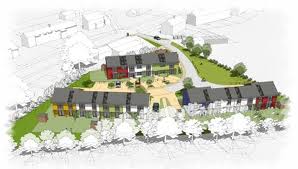The writer has been a frequent contributor to the Sunday Times Home section.
A housing association development in the Essex countryside, now nearing completion, will be one of the first in Britain to meet the exacting Passivhaus low energy standards.
The group of 14 home, which Hastoe Housing Association is putting up on a green field site by the village of Wimbish, will require little or no energy for heating or cooling. They are expected to be finished in the spring (2011).
The homes are not intended for committed environmentalists, prepared to pay a premium. On the contrary, they are for local people in housing need, for rent and shared ownership now and in the future, and they cannot be sold to the open market. Construction costs have been met with grant funding from the Housing & Communities Agency, with active support from the local councils.
Our homes and the energy we use to heat, light and run them, represents 27% of the UK’s total carbon (Co2) emissions. The UK Government wants all new homes to be zero carbon from 2016. Its long-term target is for an 80% reduction in carbon emissions by 2050.
Passivhaus is a design concept for ultra low-energy buildings, promoted by the Passivhaus Institut in Darmstadt, Germany. There are about 12,500 Passivhaus buildings worldwide, most of them in Germany and Austria,
The principles of Passivhaus address such detail as the buildings’ shape and orientation. (The Essex homes will face east and west to maximise passive solar gain, with careful attention to shading to avoid summer overheating.)
Typically Passivhaus homes incorporate very high, “tea cosy” levels of insulation, heat recovery and airtightness, through triple glazed windows and well insulated doors, and walls.They require roughly 10 times less heating (compared with conventional houses), returning huge reductions in energy costs. A €39 bill for 8 months of heating has been recorded.
The Wimbish homes will use conventional gas boilers, supplemented by solar thermal systems, such as solar panels. “Thermal stores” will supply domestic hot water, as well as feeding top-up heat into the air supplied by the heat recovery ventilation system.
“The building stays warm ‘passively’ from solar gain, appliances and people,” notes a presentation. “You could heat the house with a hair dryer.”
The homes are also expected to reach level 4 of the UK government’s Code for Sustainable Homes, which puts them close to the top of what is currently achievable under that measurement as well.
Bramall Construction is building the new homes in partnership with carbon reduction, renewable energy consultanct Inbuilt, and the Parsons & Whittley architectural practice.

